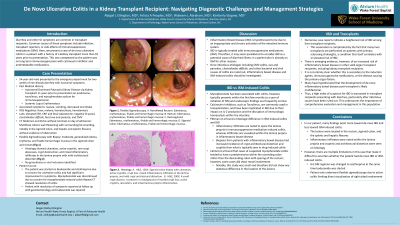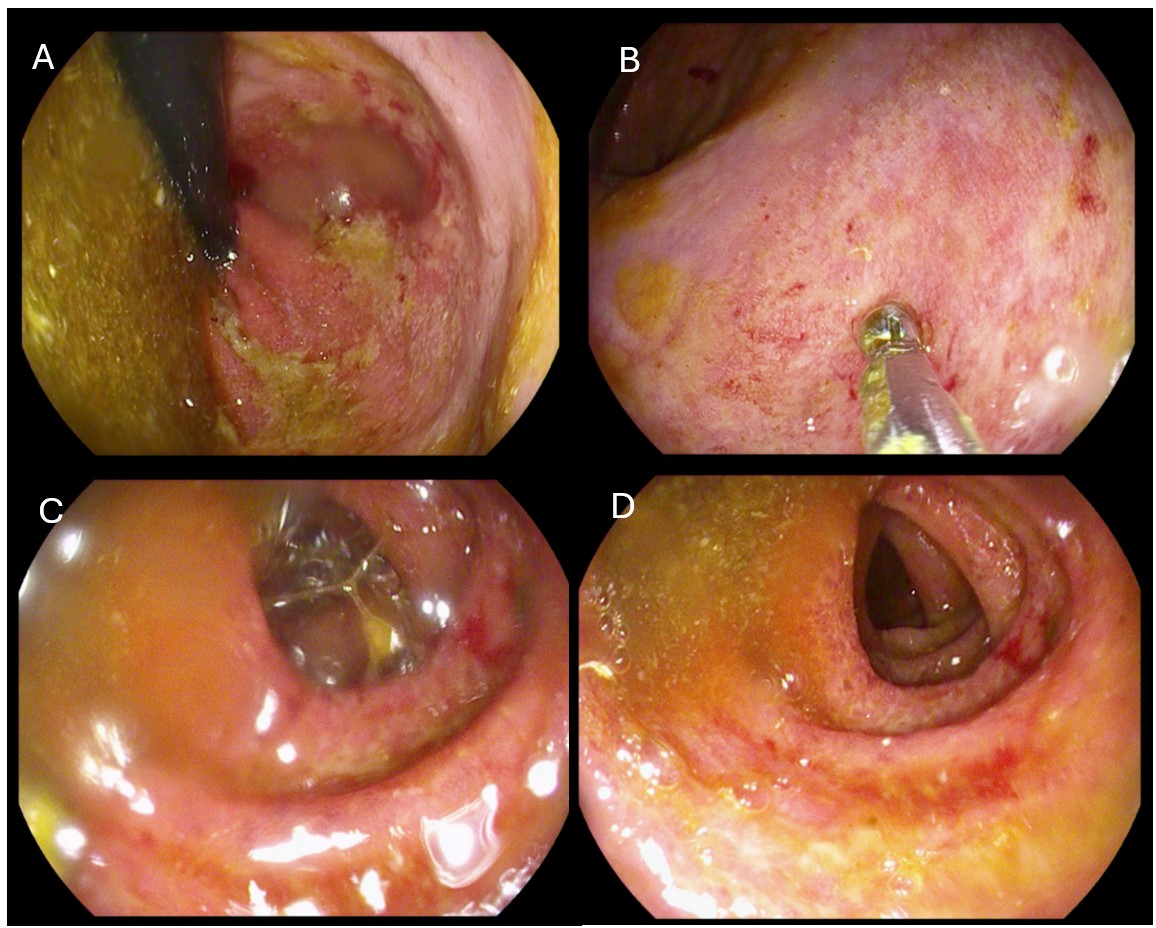Tuesday Poster Session
Category: IBD
P4454 - De Novo Ulcerative Colitis in a Kidney Transplant Recipient: Navigating Diagnostic Challenges and Management Strategies
Tuesday, October 29, 2024
10:30 AM - 4:00 PM ET
Location: Exhibit Hall E

Has Audio
- AE
Abigail L. Ellington, MD
Atrium Health Wake Forest Baptist
Winston Salem, NC
Presenting Author(s)
Abigail Ellington, MD1, Wakeem Abraham, MD1, Felicia A. Peoples, MD2, Kimberly A. Stogner, MD3
1Atrium Health Wake Forest Baptist, Winston-Salem, NC; 2Atrium Health Wake Forest Baptist, Kernersville, NC; 3Atrium Health Wake Forest Baptist Medical Center, Winston-Salem, NC
Introduction: Diarrhea is common in transplant recipients, often due to infection, transplant rejection, or side effects of immunosuppressive medications (ISM). We present a case of de-novo ulcerative colitis (UC) in a patient with a history of kidney transplant 11 years prior to presentation despite chronic ISM use.
Case Description/Methods: 54-year-old male with PMHx of SLE and ADPKD s/p transplant 11 years prior to admission presented with subacute, non-bloody diarrhea with nocturnal symptoms while on chronic ISM regimen including tacrolimus and mycophenolate sodium (MFS). Multifocal colitis seen on imaging. ISM was held and patient was started on antibiotics that were discontinued following negative infectious work-up. Labs showed elevated ESR, CRP, and fecal calprotectin. Endoscopy showed mucosal erythema, friability, and hemorrhage [Figure 1]. Biopsy showed ulceration, active cryptitis with abscesses, crypt destruction/loss, and inflammatory infiltrates in the lamina propria without viral inclusions, consistent with UC. He was started on budesonide and azathioprine. MFS was discontinued due to concerns of MFS worsening colitis. He was discharged with close follow-up, at which time budesonide was tapered.
Discussion: While paradoxical in the setting of ISM use, it is important to consider inflammatory bowel disease (IBD) as a potential diagnosis in transplant recipients presenting with diarrhea. After infectious etiologies are ruled out, the role of ISM in diarrhea and colitis should be investigated. MFS has been associated with colitis, however, typically presents within the first year, endoscopic findings are frequently normal, and the predominance of lesions are in the ascending colon. Additionally, calcineurin inhibitors, such as tacrolimus, are commonly used in transplantation, and have been implicated in IBD pathogenesis due to their impact on IL-2 production and disruption of immunologic homeostasis. Histologically, inflammatory infiltrates are noted within the lamina propria in IBD, while ISM-colitis spares the lamina propria.
While the association between IBD and liver transplantation is well-documented, there is emerging evidence suggesting increased IBD risk in other transplant recipients, including kidney transplant recipients. Thus, a high index of suspicion for IBD is warranted in transplant recipients presenting with diarrhea, particularly after infectious causes have been ruled out. This underscores the importance of comprehensive evaluation and management in this population.

Disclosures:
Abigail Ellington, MD1, Wakeem Abraham, MD1, Felicia A. Peoples, MD2, Kimberly A. Stogner, MD3. P4454 - De Novo Ulcerative Colitis in a Kidney Transplant Recipient: Navigating Diagnostic Challenges and Management Strategies, ACG 2024 Annual Scientific Meeting Abstracts. Philadelphia, PA: American College of Gastroenterology.
1Atrium Health Wake Forest Baptist, Winston-Salem, NC; 2Atrium Health Wake Forest Baptist, Kernersville, NC; 3Atrium Health Wake Forest Baptist Medical Center, Winston-Salem, NC
Introduction: Diarrhea is common in transplant recipients, often due to infection, transplant rejection, or side effects of immunosuppressive medications (ISM). We present a case of de-novo ulcerative colitis (UC) in a patient with a history of kidney transplant 11 years prior to presentation despite chronic ISM use.
Case Description/Methods: 54-year-old male with PMHx of SLE and ADPKD s/p transplant 11 years prior to admission presented with subacute, non-bloody diarrhea with nocturnal symptoms while on chronic ISM regimen including tacrolimus and mycophenolate sodium (MFS). Multifocal colitis seen on imaging. ISM was held and patient was started on antibiotics that were discontinued following negative infectious work-up. Labs showed elevated ESR, CRP, and fecal calprotectin. Endoscopy showed mucosal erythema, friability, and hemorrhage [Figure 1]. Biopsy showed ulceration, active cryptitis with abscesses, crypt destruction/loss, and inflammatory infiltrates in the lamina propria without viral inclusions, consistent with UC. He was started on budesonide and azathioprine. MFS was discontinued due to concerns of MFS worsening colitis. He was discharged with close follow-up, at which time budesonide was tapered.
Discussion: While paradoxical in the setting of ISM use, it is important to consider inflammatory bowel disease (IBD) as a potential diagnosis in transplant recipients presenting with diarrhea. After infectious etiologies are ruled out, the role of ISM in diarrhea and colitis should be investigated. MFS has been associated with colitis, however, typically presents within the first year, endoscopic findings are frequently normal, and the predominance of lesions are in the ascending colon. Additionally, calcineurin inhibitors, such as tacrolimus, are commonly used in transplantation, and have been implicated in IBD pathogenesis due to their impact on IL-2 production and disruption of immunologic homeostasis. Histologically, inflammatory infiltrates are noted within the lamina propria in IBD, while ISM-colitis spares the lamina propria.
While the association between IBD and liver transplantation is well-documented, there is emerging evidence suggesting increased IBD risk in other transplant recipients, including kidney transplant recipients. Thus, a high index of suspicion for IBD is warranted in transplant recipients presenting with diarrhea, particularly after infectious causes have been ruled out. This underscores the importance of comprehensive evaluation and management in this population.

Figure: Flexible Sigmoidoscopy. A. Retroflexed Rectum: Edematous, erythematous, friable and hemorrhagic mucosa; B. Rectum: Edematous, erythematous, friable and hemorrhagic mucosa; C. Rectosigmoid: Edematous, erythematous, friable and hemorrhagic mucosa; D. Sigmoid Colon: Edematous, erythematous, friable and hemorrhagic mucosa.
Disclosures:
Abigail Ellington indicated no relevant financial relationships.
Wakeem Abraham indicated no relevant financial relationships.
Felicia Peoples indicated no relevant financial relationships.
Kimberly Stogner indicated no relevant financial relationships.
Abigail Ellington, MD1, Wakeem Abraham, MD1, Felicia A. Peoples, MD2, Kimberly A. Stogner, MD3. P4454 - De Novo Ulcerative Colitis in a Kidney Transplant Recipient: Navigating Diagnostic Challenges and Management Strategies, ACG 2024 Annual Scientific Meeting Abstracts. Philadelphia, PA: American College of Gastroenterology.
